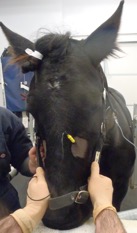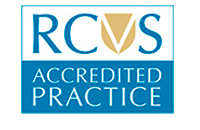24 hour contact: 01707 666297
PENS therapy for headshaking
Headshaking is an abnormal condition when a horse shakes its head in the absence of any obvious external stimulation, and with such frequency and violence that it becomes difficult or dangerous to ride, or appears to be distressed.
Case study on the use of PENS for horse headshaking: Download
How is it diagnosed?
Your vet will try to rule out all possible causes including dental, nasal and sinus conditions, orthopaedic ailments and any abnormalities of the ears and eyes.
Trial therapies include nose nets, “bute” trials, environmental changes and contact lenses.
A CT scan will often be recommended to provide a thorough assessment of the horse’s head.
A full investigation can be performed at RVC Equine.
How is it treated?
Any ailment found on the above tests will be treated to see if the headshaking resolves.
If the above tests, including a CT scan, fail to find a reason for the headshaking a presumptive diagnosis of trigeminal-mediated headshaking will be made. A nerve block may also be performed to confirm the diagnosis but not all horses respond to this.
The new treatment for trigeminal-mediated headshaking is percutaneous electoral nerve stimulation (PENS).
This is available at the RVC Equine.
What is trigeminal-mediated headshaking?
The trigeminal nerve is the main sensory nerve in the face.
Trigeminal mediated headshaking occurs due to an abnormality of this nerve resulting in a change in facial sensation or pain arising directly from the nerve itself.
It is not known why this occurs but in affected horses the nerve is over-sensitised thereby proving highly irritating to the horse.
What is PENS therapy?
PENS neuromodulation is used in the NHS for people suffering from nerve related pain.

Whilst it does not work on every case, many patients gain long term relief following the therapy. A clinical trial at the University of Bristol into the use of PENS therapy in headshaking cases showed some encouraging results.
The procedure involves electrical stimulation of the trigeminal nerve (see picture, right) in the sedated horse.
Side effects are rare and the procedure is tolerated well. It can be performed in approximately 90 minutes allowing it to be done on an out-patient basis.
We recommend a minimum of three treatments with five days between the first and the second, and 10 days between the second and the third..
What is the success rate?
In horses that have failed to respond to all other therapies a success rate of 38% has been shown.
This is defined as at least two months remission allowing a return to normal ridden work. Some horses had over two year’s remission.
If you would like to find out more, please contact RVC Equine reception on 01707 666297

